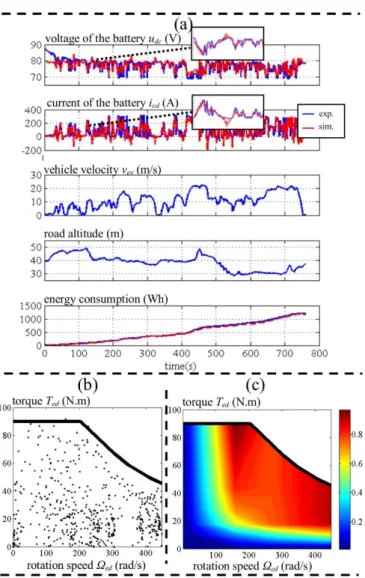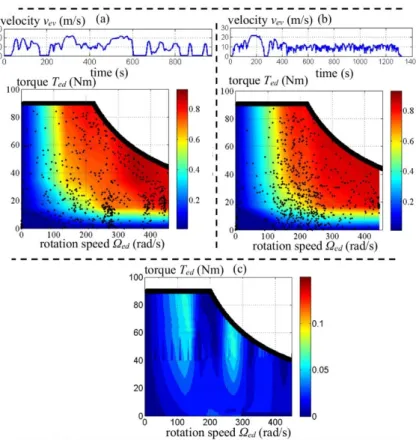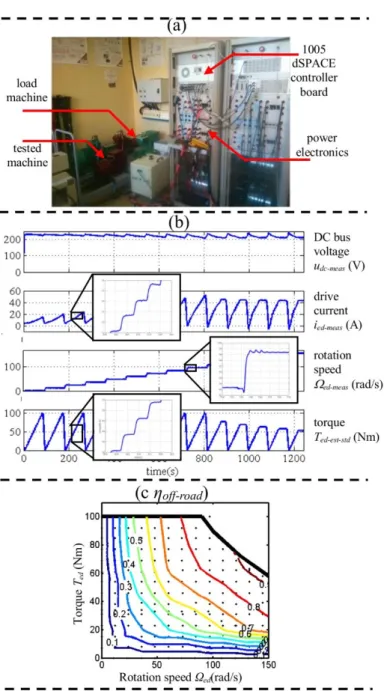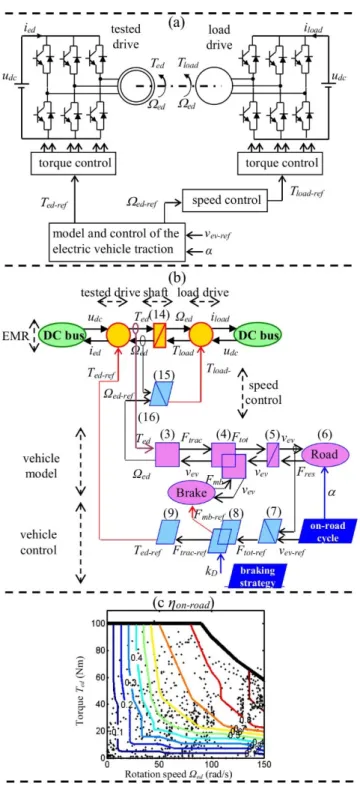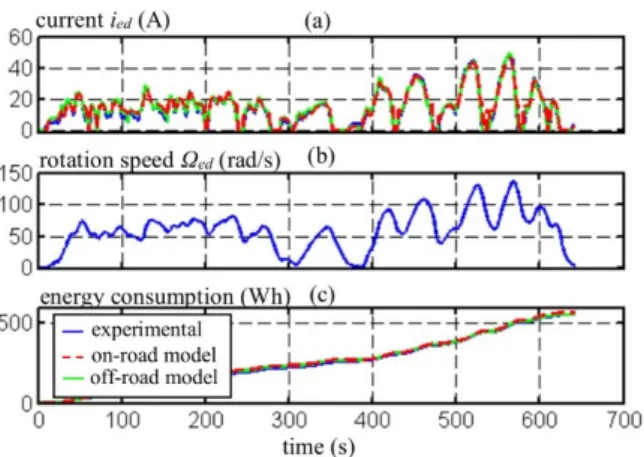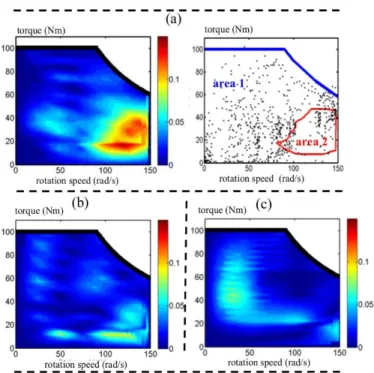Characterization of the Electric Drive of EV:
On-road versus Off-road Method
Clément Dépature1,2,3, Walter Lhomme1,3*, Alain Bouscayrol1,3,
Loïc Boulon2, Pierre Sicard2, Tommi Jokela1,4 1Lille 1 University, L2EP, Lille, France
2Université du Québec à Trois-Rivières, GRÉI, Trois-Rivières, Canada 3French network on EVs and HEVs, MEGEVH, France
4Aalto University, Espoo, Finland
*Corresponding author: Walter.Lhomme@univ-lille1.fr
Abstract: For system design, analysis of global performance and energy management of
elec-1
tric vehicles, it is common to use the efficiency map of electric traction drive. The
characteri-2
zation of the efficiency map with high accuracy is then an important issue. In this paper an
on-3
road method and an off-road method are compared experimentally to determine the efficiency
4
map of electric drive of electric vehicles. The off-road method requires a dedicated
experi-5
mental test bed, which is expensive and time-consuming. The on-road method is achieved
di-6
rectly in-vehicle. Experimental data, recorded during an on-road driving cycle, are used to
de-7
termine the efficiency map using non-intrusive measurements from GPS antenna, voltage and
8
current sensors. A versatile experimental setup is used to compare both methods on the same
9
platform. A maximal efficiency difference of 6% is achieved in most of the torque-speed plane.
10
It is shown that, in an energetic point of view, both methods yield similar results.
11
1 Introduction
12
The automotive industry is currently undergoing major changes due to the drawbacks related
13
to internal-combustion powered vehicles. The main issues are greenhouse gas emissions and
14
dependency on limited oil resources [1], [2]. New technologies such as electric, hybrid and fuel
15
cell vehicles have been proposed and are being widely developed. Electric propulsion through
16
an electric traction drive therefore represents a solution for low emission transportation [3], [4].
17
Simulation is a key issue in the development of new vehicles to benchmark, strengthen, and
18
retrofit them [5], [6]. The United States Environmental Protection Agency is, for example,
19
working on a full vehicle simulation model to measure the effective contributions from new
20
technologies [7]. However, to simulate vehicles with accuracy reliable models of the different
21
This paper is a postprint of a paper submitted to and accepted for publication in IET Electrical Systems in Transportation and is subject to Institution of Engineering and Technology Copyright. The copy of record is available at the IET Digital Library.
components are required. Steady-state models are classically used for system design [6], [8],
22
analysis of global performances [9], [10] and energy management [6], [11], [12].Steady-state
23
models consider that all transient states are negligible. They require a low computation time
24
and are based on experimental data by efficiency maps (look-up tables) [13]. The steady-state
25
model of the electric traction drive [14], [15], which includes the electric machine, the power
26
converter and their control, uses an efficiency map defined by iso-efficiency lines in the
torque-27
speed plane [16].
28
Most of the steady-state models are determined separately off-road with good accuracy [17].
29
In this way, the IEEE 112, the IEC 60349-2 and the CSA C390-93 are the most adopted
stand-30
ards for electric motors [21]-[23]. For all these standards, the instrumentation accuracy, the
31
methodology and the testing procedures are subject to specific regulations such as thermal
equi-32
librium conditions. Minor differences may then appear depending on the standard used.
Never-33
theless, the off-road characterization of stand-alone components is time-consuming and
expen-34
sive due to the need of dedicated experimental setups [18]. To characterize the electric traction
35
drive an experimental setup using a load electric drive is required [15], [19]-[21]. Furthermore,
36
the stand-alone components have to be tested outside of the vehicle. The components have then
37
to be removed from the vehicle. After it has been characterized the electric drive is remounted
38
in-vehicle with the risk of damage. The on-board constraints of the vehicle, like the temperature
39
or the electromagnetic compatibility of the devices near to the tested stand-alone components,
40
cannot also be taken into account.
41
To tackle these issues, other methods are developing for characterization directly in-vehicle.
42
The actual methods are composed of extensive tests on specific rolling test benches (chassis
43
dynamometers). Additional measurements are classically used in-vehicle to characterize the
44
components of the vehicle like the electric drive [24], [25], the internal combustion engine [26]
45
or the transmission [27]. When it is accessible, the on-board CAN messages can also be directly
used to extract data and define the model of components [18]. Nevertheless, even if the tests
47
are performed in-vehicle, all of these determination procedures are characterized off-road with
48
a specific costly chassis dynamometer.
49
To avoid the use of a chassis dynamometer a new in-vehicle and on-road method has been
50
proposed in [28]. From a real driving cycle the efficiency map of the electric traction drive is
51
characterized using non-intrusive measurements from GPS antenna, voltage and current
sen-52
sors. The torque of the electric drive is estimated from the parameters of the vehicle and the
53
additional measurements. The on-road method has been applied successfully and validated to a
54
commercial Electric Vehicle (EV), the Tazzari Zero [29].
55
The objective of this paper is to compare experimentally the stand-alone off-road and the
56
new on-road method to determine the efficiency map of electric traction drive of EVs. As the
57
off-road method is the reference in the literature, it is used as reference in this paper. In section
58
II, the on-road and off-road methods are presented, with their application to a real commercial
59
EV. In section III, both methods are applied to a versatile experimental setup. Finally the
accu-60
racy and limitation of the methods are discussed in section IV.
61
2 Characterization of the electric drive of a commercial EV
62
2.1 Studied vehicle
63
The studied traction system of the EV is composed of a battery, a Voltage-Source-Inverter
64
(VSI), a three-phase induction machine, a gearbox, a mechanical differential and two driven
65
wheels (Fig. 1a). To introduce the on-road and off-road methods, a global model of the vehicle
66
and its control are first developed. As the paper deals with efficiencies, energetic models are
67
sufficient in this work. The equations of the vehicle model are summarized under Table 1. All
68
the variables are listed in Table 4 and Table 5 in the appendix. The complete model of the
69
vehicle is detailed in [28].
70
Table 1. Mathematical model of the electric vehicle 71
Battery udc u SoC0
R ibat ed (1) Electric drive
, ed ed ref m ed ed dc ed ed ed ed T T P T u i T (2) Equivalent wheel (“bicycle model”)
/ / trac gb wh ed gb ed gb wh ev F k r T k r v with m m 1 when P 0 1 when P 0 (3) Chassis tot trac mb F F F (4) ev tot res d M v F F dt (5)Environment Fres 0.5AC vx ev2Mg
sin fr
(6)72
a Architecture b EMR and control
c Tazzari Zero and supplementary sensors into the rear boot
Let us focus on the electric drive model, which is composed of the VSI, the induction ma-chine and the associated control (a torque control is considered). With a steady-state model, it is assumed that the generated torque Ted is equal to its reference Ted-ref [30]. Moreover, the
me-chanical power Pm is expressed from the electrical power through the efficiency ed from (2).
As the efficiency depends on the operating point, a look-up table generally expresses the efficiency ed from the torque Ted and the rotation speed ed to determine the current of the
electric drive ied, i.e. the input current of the VSI [14]-[16].
The models are interconnected using Energetic Macroscopic Representation (EMR). By a systemic approach, the objective of EMR is to establish a functional description of an energetic system for its control [31]. It describes the energy exchange between components of a system following the causality principles. The system is decomposed into basic subsystems in interac-tion (cf. Table 6 of the appendix): energy sources, accumulainterac-tion elements, conversion elements and coupling elements for energy distribution. Many electric and hybrid vehicles have been studied using EMR [12], [32]-[35]. The EMR of the studied system is represented in Fig. 1b. Moreover, EMR enables a deduction of control schemes by an inversion principle. The vehicle control can then be defined. The driver acts as a closed-loop controller of the velocity vev to
define the total reference force Ftot-ref by acting on the acceleration and braking pedals:
( )
tot ref ev ref ev meas
F C t v v (7)
with C(t) a controller, which could be a neural network controller in the case of the driver. The total reference force Ftot-ref is then distributed into the traction force reference Ftrac-ref and the
mechanical braking force reference Fmb-ref by an inversion of (4):
(1 )
trac ref D tot ref mb ref D tot ref
F k F F k F (8)
with kD a distribution input, which is defined by a strategy: kD=1 in traction mode and kD defined
for a maximal electrical braking in braking mode (0 ≤ kD ≤ 1). The reference of the drive torque
Ted-ref is finally obtained by an inversion of (3):
wh g
trac refref
ed r k F
T / (9)
2.2 Off-road method characterization
73
Let us assume that vehicle parameters are known, except the electric drive efficiency map.
74
If the electric drive can be removed from the vehicle, it can be connected to a load electric drive
75
and all tests can be run to define the efficiency map. A load machine is then connected to the
76
shaft of the tested electric machine. Here, the off-road method corresponds to the method A of
77
the IEEE 112 test procedure for electric machines [21] extended to tested electric drives [15].
78
Such a method requires speed control of the load electric drive and measurements of the voltage
79
udc, current ied, rotation speed ed and torque Ted. These variables correspond to the inputs and 80
outputs of the electric drive model depicted by the EMR (orange circle in Fig. 1b). The
effi-81
ciency is then derived from (2):
82
meas ed meas dc meas ed meas ed in out ed ed ed i u T P P T , (10)A look-up table is then built off-line by imposing different operating points to the tested
83
electric drive. To build a matrix for the torque-speed plane, the tested drive is thereby controlled
84
to impose the torque Ted-ref while the load electric drive is controlled to impose the rotation 85
speed ed-ref (Fig. 2a). Consequently, all operating points can be covered by changing the ref-86
erence values in the matrix {Ted-ref, ed-ref}. The finite number of the operating points recorded 87
can afterward be extended to a continuous efficiency map by interpolation and extrapolation
88
[36].
89
It should be noted that the off-road method assumes operation in steady-state to calculate the
90
efficiency of each operating point, thus neglecting transient states. The measurements must then
be carried out after the transient states. Furthermore the calculation of the efficiency requires
92
the measurement of the torque. A torque sensor, which is generally expensive, is necessary.
93
Another possibility is to use an estimator based on the parameters and measurement of the
94
electric drive currents [37].
95
In the case of the electric drive characterization of a commercial EV, the use of the off-road
96
method is not convenient. This method requires to remove the electric drive from the vehicle
97
and install it on the test bed to be finally remounted in the vehicle with the risk of damage. To
98
tackle this issue, an on-road method can been used to avoid the use of such an intrusive method.
99
Fig. 2 Methods to determine the efficiency map of an electric drive
a Off-road method b On-road method
2.3 On-road method characterization
A new on-road method has been proposed in [28] to determine an efficiency map using a
101
real on-road driving cycle. Two issues have to be solved to determine the efficiency map. First,
102
all the required measurements are generally not available, such as the torque of the electric
103
drive. Second, steady-state operating points are not imposed by an on-road drive cycle and do
104
not span the full torque-speed plane.
105
In the vehicle, only global sensors can be implemented without major changes (non-intrusive
106
measurements). The measurements of the battery voltage and current can be easily integrated.
107
The measurements of the rotation speed and of the torque of the electric machine cannot be
108
implemented as easily. A GPS (Global Positing System) is a widely used non-intrusive sensor
109
that provides the vehicle position and altitude, which can be converted into the vehicle velocity
110
vev and slope . These available measurements are not close to the mechanical input and output 111
of the electric drive, ed and Ted. 112
A first issue of the on-road method is to estimate the rotation speed and torque of the electric
113
drive from the available measurements (Fig. 2b). From (3) the rotation speed can be estimated
114
using the measurement of the velocity:
115
g wh
ve meas ested k r v
/ (11)
As in general the braking strategy of commercial vehicles is not well-known by the users,
116
only the traction mode is studied. The efficiency map will be then studied in the first quadrant
117
of the torque-speed plane. In traction mode, from (3), (5) and (6) the drive torque Ted can be 118
estimated using the measurements of the velocity vev and slope angle : 119
ev x ev meas meas r g k g wh est ed pAC v Mg f dt dv M k r T 0.5 2 sin (12)This estimation requires the derivative of the velocity that leads to an approximation. Using
estimations, ed-est and Ted-est, the efficiency of the electric drive can be defined using the meas-121
urements of the battery voltage udc and current ied: 122
meas ed meas dc est ed est ed est in est out est ed est ed est ed i u T P P T , (13)A second issue of the on-road method is the available operating points during the on-road
123
drive cycle. Because of the dynamical nature of the identification process, the torque-speed data
124
points are recorded in an unorderly fashion, with unevenly distributed data and unexplored
re-125
gions in the plane. The drive cycle has to be as varied as possible to obtain operating points that
126
cover large areas of the torque-speed plane. An off-line algorithmic method was proposed in
127
[28] to obtain a complete efficiency map, with uniformly distributed data points from the
rec-128
orded data (estimated torque Ted-est and speed Ωed-est data vectors and resulting efficiency ηed-est) 129
following the following main steps:
130
1. round the data according to the desired quantization for velocity and torque points
131
on the grid;
132
2. sort the data, averaging efficiency for repeated points;
133
3. remove outliers;
134
4. fill gaps in the map by using linear interpolation;
135
5. complete the borders of the map by setting the efficiency to the same value as the
136
estimated efficiency at the last points of the map.
137
The on-road method has been applied to a commercial EV, the Tazzari Zero [29] (Fig. 1c,
138
Table 2). The vehicle, propelled by an induction machine of 15 kW, has been instrumented with
139
sensors of the battery voltage and current as well as a GPS antenna with a velocity accuracy of
140
0.1 m/s. An on-board acquisition system (CompactRIO, National Instrument) acquires the data
141
every 0.5 s. The acquisition system is powered by two additional lead-acid batteries (12 V, 17.5
142
Ah). The power consumption of the acquisition system then does not alter the energy flow of
143
the EV.
145
Table 2. Electric vehicle parameters 146 parameter value gearbox ratio kgb 5.84 gearbox efficiency gb 0.98 wheels radius rwh [m] 0.2865 curb mass [kg] 562 A·Cx [m2] 0.7 fr 0.02
An extra-urban drive cycle has been carried out at University of Lille 1, in France, on and
147
around campus. The measurements are recorded by the on-board acquisition system: battery
148
voltage udc, battery current ied, vehicle velocity vev, and altitude (blue curves in Fig. 3a). The 149
velocity reaches a maximum of 80 km/h (22 m/s). From that data, parameters of Table 2 and
150
the measured slope αmeas are implemented off-line in (12) to define the estimated torque Ted-est. 151
The rotation speed ed is estimated off-line using (11). The efficiency is then calculated for 152
each operating point using (13). A first efficiency map has been built for the operating points
153
of the driving cycle (Fig. 3b). It should be noted that the operating points cover most of the
154
torque-speed plane. It could be improved by a more adapted drive cycle, which can be studied
155
in further works. From the initial efficiency map, the off-line algorithm of [28] is used to obtain
156
the final efficiency map (Fig. 3c). This on-road efficiency map can then be used in simulation.
157
Simulation results with the obtained efficiency map of Fig. 3c show some dynamical errors
158
in comparison with the experimental results (Fig. 3a). The average error of the current of the
159
machine is 2 % on the duration of the driving cycle. In term of energy consumption less than
160
3.5 % average error is yielded.
161
In the on-road method, operating points and the dynamic conditions are influenced by the
162
driver behaviors. Fig. 4 presents the electric drive efficiency map of the Tazzari Zero, deduced
from two different driving cycles. It should be noted that the obtained efficiency maps are
sim-164
ilar to the previous one (Fig. 3c). The absolute difference of the efficiency maps from (a) and
165
(b) is presented in (c). The global average difference is 2.4 % for a standard deviation of 1.79 %,
166
what means that both efficiency maps are quite similar. The on-road method is then repeatable
167
and applicable for any instrumented vehicle.
168
Fig. 3 Results for the on-road method
a Experimental and simulation results
b On-road test operating points of the efficiency map c Final on-road efficiency map after processing
169
Fig. 4: On-road efficiency maps of the studied electric vehicle for different driving cycles
170
a efficiency map of the driving cycle 1
171
b efficiency map of the driving cycle 2
172
c absolute difference between efficiency maps of the driving cycles 1 and 2
173
3 Application to a Versatile Experimental Setup 174
To compare in an effective way both methods a versatile experimental setup is necessary.
175
This setup has to be capable to test both methods with the same platform. The experimental
176
setup is then composed of a Voltage-Source-Inverter (VSI) and an induction machine under test
177
connected to a load electric machine with its own VSI. For the on-road method the load electric
178
drive is controlled by a Hardware-In-the-Loop (HIL) simulation technique [38] to emulate the
179
mechanical part of the vehicle. For the off-road method the load electric drive is controlled to
180
impose the rotation speed. The on-road efficiency map can consequently be compared to the
181
off-road efficiency map with the same experimental setup.
3.1 Experimental setup
183
A 20 kW induction machine, its VSI and its torque control are considered as the tested
elec-184
tric drive (Fig. 5a). The load electric drive is composed of a 20 kW permanent magnet
synchro-185
nous machine, its VSI and its torque control. A 1005 dSPACE controller board is used with a
186
sampling period of Tsamp=100 µs and a switching frequency of fsw=10 kHz. 187
Fig. 5 Off-road method applied on the versatile experimental setup
a Versatile experimental setup
b Experimental results of the electric drive c Off-road efficiency map of the electric drive
188 189
Both electric machines are connected by a common shaft. The rotation speed ed is a func-190
tion of the tested electric drive and load torques, Ted and Tload: 191
ed ed load ed
d
J T T f
dt (14)
where J and f are the inertia and friction coefficient of the shaft. To impose the rotation speed
192
ed-ref to the load electric drive (see Fig. 2a), the load torque reference Tload-ref is determined by 193
an inversion of (14):
194
( )
load ref ed ref ed meas
T C t (15)
with C(t) the speed controller. Classical field oriented control is used for both electric drives 195
to set their torque references [39]. The rotation speed ed and torque Ted can then be imposed 196
to the tested electric drive. Because there is no torque sensor on the experimental setup, the
197
torque of the tested electric drive is estimated from the classical relation using the measurement
198
of the currents and rotation speed of the tested induction machine [37]:
199
sr
ed est std rd est sq est r
M
T p i
L
with rd est ,isq est f i
1,2meas,ed meas
(16)where Lr is the rotor inductance of the induction machine, Msr the mutual inductance between 200
the stator and rotor, p the pole pair number, rd the d-axis rotor flux, isq the q-axis stator current 201
and i1,2 the electric machine current vector. This estimation has been shown to have a good 202
correlation with the measured electric drive torque [37].
203
3.2 Off-road efficiency map
204
The standard IEEE 112 procedure [21] is extended to the electric drive [15] to determine the
205
off-road efficiency map. Different operating points are imposed to the tested drive with a 14×14
206
matrix for the torque-speed plane. Rotation speed steps of 12 rad/s are imposed from 0 to 157
207
rad/s (ed-ref). For each value of rotation speed, torque steps of 7.7 Nm are imposed from 0 to 208
100 Nm (Ted-ref, Fig. 5b). For each operating point, the measurements are carried out in steady-209
state (black dots in Fig. 5c). The number of operating points has been defined to give enough
points to construct an efficiency map of high quality without relying too much on interpolation.
211
The efficiency map is then calculated using (13) from the measurements of the dc bus voltage
212
udc-meas, electric drive current ied-meas, rotation speed ed-meas and the estimation of the torque T ed-213
est-std (Fig. 5b) using (16). The torque-speed plane is composed of regularly spaced operating 214
points, and iso-efficiency lines can be plotted (Fig. 5c).
215
3.3 On-road efficiency map
216
To reproduce the on-road method on the experimental setup, the rotation speed and torque
217
references are imposed using a power HIL simulation of the vehicle (Fig. 6a). Power HIL
sim-218
ulation [38] is more and more used to test Electronic Control Unit (ECU) and power
compo-219
nents before their implementation in an actual system. EMR is a useful tool to organize HIL
220
simulation. It has often been used for the description of HIL simulation for electric and hybrid
221
vehicles [35], [40].
222
In our case, the estimated torque Ted-est-std of the tested electric drive is sent to mathematical 223
model of the mechanical transmission and deduced from the EMR of Fig. 1b (purple part in
224
Fig. 6b). This torque estimation is defined from the current and speed measurements (16) to be
225
as close as possible to the real torque. From interactions between all models of mechanical
226
components, the rotation speedis generated (ed-ref in Fig. 6b). This rotation speed is used as a 227
reference for the speed control of the load electric drive. Moreover, the vehicle control defines
228
the torque reference of the tested electric drive Ted-ref. The model of the vehicle, control of the 229
vehicle and controls of both electric drives are computed in real time on a 1005 dSPACE
con-230
troller board. In comparison with the off-road method, the rotation speed and torque references
231
are not defined by steps, but by the dynamical behaviour of the simulated vehicle with its model
232
and control (as in the real vehicle).
Fig. 6 On-road method applied on the versatile experimental setup
a Power HIL simulation of the studied electric vehicle b EMR and control of the power HIL simulation c On-road efficiency map of the electric drive
The measurement of the velocity vev of the on-road drive cycle of the EV Tazzari Zero, see 234
Fig. 3a, is imposed as a reference to the vehicle control (vev-ref in Fig. 6b). The measurement of 235
the altitude, see Fig. 3a, is imposed to the road model to determine the slope (“Road” element
236
in Fig. 6b). The on-road drive cycle is thus reproduced to the experimental setup. The efficiency
map is built in the same way than for the EV with the measurements of the dc bus voltage udc, 238
drive current ied, vehicle velocity vev and also the estimation of the torque Ted using (12) with 239
the vehicle velocity and road slope. The on-road efficiency map (Fig. 6c) is relatively close to
240
the off-road efficiency map (Fig. 5c), even though it is obtained from transient operation.
241
4 Comparison of the Methods
242
The on-road and off-road methods do not use the same procedure to determine the efficiency
243
map of an electric drive of an EV. Different assumptions and approximations are considered
244
for both methods. First, the electrical torque is estimated in a different way. The electrical torque
245
is estimated from the velocity measurement in the on-road method while it is estimated from
246
the measurement of the current in the off-road method. Second, the efficiency map is built in
247
transient states for the on-road method whereas it is built in steady-state for the off-road method.
248
Other errors occur due to the sensor accuracies, but they do not have to be considered because
249
the sensors are the same for the on-road and off-road methods during the tests on the
experi-250
mental setup.
251
4.1 Differences of the efficiency maps
252
To further validate the efficiency map of both on-road and off-road methods a measurements
253
with a new driving cycle, different from the one that has been used to determine the efficiency
254
map of Fig. 6c, has been performed (Fig. 7). The efficiency maps are then tested with other
255
operating points. For the on-road method, the comparison between experimental and simulation
256
results gives an average error of 1.7 % for the current and 1.9 % for the energy consumption.
257
For the off-method, an average error of 0.35 % for the current and 0.3 % for the energy
con-258
sumption is obtained. The high accuracy between experimental and simulation results allows
259
to validate the obtained efficiency maps. Both methods are then validated.
260 261
262
Fig. 7 Validation of the efficiency maps of both on-road and off-road methods on a new driving cycle 263
To compare the efficiency maps of each method, the difference between the two maps is
264
calculated as follows and plotted in Fig. 8a.
265
off-road on-road
difference (17)
Two areas can be considered (Fig. 8a). In area 1 the average difference of the efficiencies is
266
3 % with a maximal difference of 6 %. In this area, the on-road efficiency map can be
consid-267
ered accurate enough to represent the electric drive for energetic studies. In area 2, at low
tor-268
ques and high speeds, the average difference is 10 % with a maximal difference of 14 %. The
269
area with the highest difference corresponds simultaneously to a region with few operating
270
points for the on-road method (black dots in Fig. 8a), and with a large gradient of efficiency
271
about torque. The global average difference, with areas 1 and 2, is 3.3 % for a standard deviation
272
of 3.15 %, what means that 68% of values fall within 1 standard deviation of the average. All
273
the comparison results are summarized in Table 3. The effects of torque estimation and of
tran-274
sient states are evaluated in the next subsections.
275
4.2 Influence of the torque estimation
276
In the on-road method, the estimation of the torque is achieved from the derivation of the
277
velocity measurement using the mechanical load model (12). In the off-road method the
esti-278
mation of the torque is carried out using the measurements of the current and the rotation speed
279
using the electromagnetic model of the motor (16).
Fig. 8 Absolute difference between efficiency maps
a Original on-road versus off-road method
b On-road method with electromagnetic torque estimation versus original off-road method c Off-road method with torque ramp profile versus original off-road method
Another on-road efficiency map is built from the on-road method. (Fig. 8b) To avoid the
281
derivation of the measurement of the velocity the electromagnetic torque estimation (16) is then
282
used. For this test only the torque estimation for the on-road method has been changed. The
283
characterization is still the same with a building of the efficiency map in transient states for the
284
on-road method and in steady-state for the off-road method. When comparing Fig. 8a and Fig.
285
8b, the use of the electromagnetic torque (16) leads to a smaller absolute difference on the
286
overall plane, except for some isolated regions. It should be noted that these regions correspond
287
to areas of the plane with gaps in experimental data points (black dots on Fig. 8a). The
maxi-288
mum difference on area 2 of Fig. 8b has been significantly reduced down from 14 % to 8 %. It
289
can be concluded that torque estimation plays an important role in efficiency estimation and
290
that it accounts for a large portion of the difference in area 2. More accurate torque estimation,
291
such as closed loop observation, could improve the results of the on-road efficiency map. The
292
average difference is 2.2 % with a standard deviation of 1.76 % (Table 3).
293 294
4.3 Influence of the transient states
295
To measure the impact of the transient states, the off-road method is modified to use
meas-296
urements during transients: instead of imposing torque steps and waiting for steady-state, a
297
ramp is used for the reference torque. A new efficiency map is then built and compared to the
298
efficiency map obtained with the original off-road method of Fig. 5b (Fig. 8c). For this test only
299
the reference torque of the off-road method has been changed. The torque estimation does not
300
change: derivation of the velocity for the on-road method and measurements of the machine
301
current for the off-road method.
302
A maximal difference of 6% is concentrated for low rotation speeds with medium torques
303
(Fig. 8c). Overall, the use of transient states represents only a difference of efficiency of 2%
304
and is not the main factor for the accuracy of the results. It can be concluded that the transient
305
measurements affect the efficiency estimation, but play a minor role as compared to lack of
306
measurement points and quality of torque estimation. The average difference is 2.15 % with a
307
standard deviation of 1.18 % (Table 3).
308
Table 3. Statistical analysis differences 309
Comparison On-road vs off-road torque estimation Influence of the Influence of the transient states
Average difference 3.33 % 2.2 % 2.15 %
Standard deviation 3.15 % 1.76 % 1.18 %
5 Conclusion
311
Two methods to determine the efficiency map of the electric drive of EVs have been
com-312
pared experimentally. An off-road method allows determining the efficiency map with a
dedi-313
cated experimental test bed. This standard method is accurate, but suffers from application
con-314
straints. An on-road method allows determining the efficiency map directly in-vehicle by an
315
on-road drive cycle. The on-road method is repeatable and convenient to use but, as it is a new
316
method, its reliability is unknown. To compare in an effective manner both methods, a versatile
317
experimental setup has been used. To reproduce the behaviour of the EV, a power
Hardware-318
In-the-Loop simulation technique has been used. By this way, the on-road efficiency map has
319
been compared with the map obtained with the off-road method. It has been shown that, in an
320
energetic point of view, both methods yield similar results. Our comparison demonstrates an
321
absolute difference of the efficiency lower than 6% in most of the torque-speed plane. The
322
principal differences come from the lack of measurement points for the on-road method due to
323
the on-road driving cycle. The quality of torque estimation also affects the results. Furthermore,
324
the efficiency map is built in transient states for the on-road method whereas it is built in
steady-325
state for the off-road method. The experimental results show that the transient nature of
meas-326
urements has a minor influence on the map accuracy as compared to lack of measurement points
327
and quality of torque estimation. For the benchmarking of commercial vehicle, as it is not
nec-328
essary to remove the electric drive from the vehicle, the on-road method can be more efficient,
329
gains research time, and avoids the risk of damage. The new on-road method can then be used
330
for energetic studies. For future work, more accurate torque estimation is required to increase
331
the accuracy of the on-road efficiency map in sensitive areas. Furthermore, the new on-road
332
method could be used to compare different commercial EVs.
333 334
6 References
335
[1] Chan, C.C.: ‘Overview of Electric, Hybrid and Fuel Cell Vehicles’, in Crolla, D. (Ed.):
336
‘Encyclopedia of Automotive Engineering’ (Wiley-Blackwell, 2015), pp. 971-974
337
[2] Zhong, F., Martinez, O., Gormus, R., et al.: ‘The reign of EV’s? An economic analysis from
338
consumer’s perspective’, IEEE Electrification Magazine, 2014, 2, (2), pp. 61-71
339
[3] Khaligh, A., Li, Z.: ‘Battery, ultracapacitor, fuel cell, and hybrid energy storage systems for
340
electric, hybrid electric, fuel cell, and plug-in Hybrid Electric Vehicles: state-of-the-art’,
341
IEEE Trans. on Vehicular Technology, 2010, 59, (6), pp. 2806-2814
342
[4] Ehsani, M., Gao, Y., Gay, S.E., et al.: ‘Modern electric, hybrid electric, and fuel cell
vehi-343
cles’ (CRC Press, 2009, 2nd edn.)
344
[5] Gao, D.W., Mi, C., Emadi, A.: ‘Modeling and simulation of electric and hybrid vehicles’,
345
Proceedings of the IEEE, 2007, 95, (4), pp. 729–745
346
[6] Guzzella, L., Sciarretta, A.: ‘Vehicle propulsion systems, introduction to modelling and
op-347
timization’ (Springer-Verlag Berlin and Heidelberg GmbH & Co, 2015, 3rd edn.)
348
[7] Lee, B., Lee, S., Cherry, J., et al.: ‘Development of advanced light-duty powertrain and
349
hybrid analysis tool’, SAE 2013 World Congress & Exhibition, 2013
350
[8] Vinot, E., Trigui, R., Cheng, Y., et al.: ‘Improvement of an EVT-based HEV using dynamic
351
programming’, IEEE Trans. on Vehicular Technology, 2014, 63, (1), pp. 40-50
352
[9] Lazari, P., Wong, J., Chen, L.: ‘A computationally efficient design technique for
electric-353
vehicle traction machines’, IEEE Trans. on Industry Applications, 2014, 50, (5), pp.
3203-354
3213
355
[10] Jurkovic, S., Rahman, K.M., Morgante, J.C., et al.: ‘Induction machine design and
anal-356
ysis for general motor e-assist electrification technology’, IEEE Trans. on Industry
Appli-357
cations, 2015, 51, (1), pp. 631-639
[11] Patil, R.M., Filipi, Z., Fathy, H.K.: ‘Comparison of supervisory control strategies for
359
series plug-in hybrid electric vehicle powertrains through dynamic programming’, IEEE
360
Trans. on Control Systems Technology, 2014, 22, (2), pp. 502-509
361
[12] Mayet, C., Pouget, J., Bouscayrol, A., et al.: ‘Influence of an energy storage system on
362
the energy consumption of a diesel-electric locomotive’, IEEE Trans. on Vehicular
Tech-363
nology, 2014, 63, (3), pp. 1032-1040
364
[13] Chan, C.C., Bouscayrol, A., Chen, K.: ‘Electric, hybrid and fuel cell vehicles:
architec-365
tures and modeling’, IEEE Trans. on Vehicular Technology, 2010, 59, (2), pp. 589-598
366
[14] Buyukdegirmenci, V.T., Bazi, A.M., Krein, P.T.: ‘Evaluation of induction and PM
syn-367
chronous machines using drive-cycle energy and loss minimization in traction application’,
368
IEEE Trans. on Industry Applications, 2014, 50, (1), pp. 395-403
369
[15] Estima, J.O., Marques Cardoso, A.J.: ‘Efficiency analysis of drive train topologies
ap-370
plied to electric/hybrid vehicles’, IEEE Trans. on Vehicular Technology, 2012, 61, (3), pp.
371
1021-1031
372
[16] Williamson, S.S., Lukic, S.M., Emadi, A.: ‘Comprehensive drive train efficiency
anal-373
ysis of hybrid electric and fuel cell vehicles based on motor-controller efficiency
model-374
ling’, IEEE Trans. on Power Electronics, 2006, 21, (3), pp. 730–740
375
[17] Cao.W: ‘Comparison of IEEE 112 and new IEC standard 60034-2-1’, IEEE Trans. on
376
Energy Conversion, 2009, 24, (3), pp. 802-808
377
[18] Moskalik, A., Dekraker, P., Kargul, J., et al.: ‘Vehicle component benchmarking using
378
a chassis dynamometer’, SAE International Journal of Materials and Manufacturing, 2015,
379
8, (3), pp. 869-879
380
[19] Bojoi, R., Armando, E.,Pastorelli, M., Lang, K.: ‘Efficiency and loss mapping of AC
381
motors using advanced testing tools’, 2016 XXII International Conference on Electrical
382
Machines (ICEM), 2016
[20] Boglietti. A, Cavagnino. A, Lazzari. M, Pastorelli. M.: ‘International standards for the
384
induction motor efficiency evaluation: a critical analysis of the stray-load loss
385
determination’, IEEE Trans. on Industry Applications, 2004, 40, (5), pp. 1294-1301
386
[21] IEEE Std 112-1996: ‘IEEE standard test procedure for polyphase induction motors and
387
generators’, 1997
388
[22] IEC 60349-2: ‘Electric traction – rotating electrical machines for rail and road vehicles
389
– Part 2: Electronic converter-fed alternating current motors’, 2010.
390
[23] CSA Std C390-93: ‘Energy efficiency test methods for three-phase induction motors’,
391
1993.
392
[24] Wang, R., Chen, Y., Feng, D., et al.: ‘Development and performance characterization
393
of an electric ground vehicle with independently actuated in-wheel motors’, Journal of
394
Power Sources, 2011, 196, (8), pp. 3962-3971
395
[25] Kim, S., Park, S., Park, T., et al.: ‘Investigation and experimental verification of a novel
396
spoke-type ferrite-magnet motor for electric-vehicle traction drive applications’, IEEE
397
Trans. on Industrial Electronics, 2014, 61, (10), pp. 5763-5770
398
[26] Bohn, T., Duoba, M.: ‘Implementation of a non-intrusive in-vehicle engine torque
sen-399
sor for benchmarking the Toyota Prius’, SAE 2005 World Congress & Exhibition, 2005
400
[27] Irimescu, A., Mihon, L., Pãdure, G.: ‘Automotive transmission efficiency measurement
401
using a chassis dynamometer’, International Journal of Automotive Technology, 2011, 12,
402
(4), pp. 555-559
403
[28] Dépature, C., Lhomme, W., Bouscayrol, A., et al.: ‘Efficiency map of the traction
sys-404
tem of an electric vehicle from an on-road test drive’, 2014 IEEE Vehicle Power and
Pro-405
pulsion Conf. (VPPC), 2014
406
[29] ‘Tazzari zero website’, http://www.tazzari-zero.com/, accessed 8 August 2016
[30] Letrouvé, T., Bouscayrol, A., Lhomme, W., et al: ‘Different models of a traction drive
408
for an electric vehicle simulation’, 2010 IEEE Vehicle Power and Propulsion Conf. (VPPC),
409
2010
410
[31] Bouscayrol, A., Hautier, J.P., Lemaire-Semail, B.: ‘Graphic formalisms for the control
411
of multi-physical energetic systems: COG and EMR’, in Roboam, X. (Ed.): ‘Systemic
de-412
sign methodologies for electrical energy systems: analysis, synthesis and management’
413
(John Wiley & Sons, 2012)
414
[32] Castaings, A., Lhomme, W., Trigui, R., et al.: ‘Practical control schemes of a
battery/su-415
percapacitor system for electric vehicle’, IET Electr. Syst. Transp., 2016, 6, (1), pp. 20-26
416
[33] Lhomme, W., Trigui, R., Delarue, P., et al.: ‘Switched causal modelling of transmission
417
with clutch in hybrid electric vehicles’, IEEE Trans. on Vehicular Technology, 2008, 57,
418
(4), pp. 2081-2088
419
[34] Allègre, A.-L., Bouscayrol, A., Trigui, R.: ‘Flexible real-time control of a hybrid energy
420
storage system for electric vehicles’, IET Electr. Syst. Transp., 2013, 3, (3), pp. 79–85
421
[35] Letrouvé, T., Lhomme, W., Bouscayrol, A., et al.: ‘Control validation of Peugeot 3∞8
422
Hybrid4 vehicle using a reduced-scale power HIL simulation’, Journal of Electrical
Engi-423
neering and Technology, 2013, 8, (5), pp. 1227-1233
424
[36] Deprez, W., Lemmens, J., Vanhooydonck, D., et al.: ‘Iso-efficiency contours as a
con-425
cept to characterize variable speed drive efficiency’, 2010 International Conf. on Electrical
426
Machines (ICEM), 2010
427
[37] Bastiaensen, C., Deprez, W., Symens, W., et al.: ‘Parameter sensitivity and
measure-428
ment uncertainty propagation in torque-estimation algorithms for induction machines’,
429
IEEE Trans. on Instrumentation and Measurement, 2008, 57, (12), pp. 2727-2732
430
[38] Bouscayrol, A.: ‘Hardware-in-the-loop simulations’, in Wilamowski, B.M., Irwin, J.D.
431
(Ed.): ‘The Industrial Electronics Handbook’ (CRC Press, 2011, 2nd edn.)
[39] Sul, S.K.: ‘Control of electric machine drive systems’ (Wiley-IEEE Press, 2011)
433
[40] Allègre, A.L., Bouscayrol, A., Verhille, J.N., et al.: ‘Reduced-scale-power
hardware-in-434
the-loop simulation of an innovative subway’, IEEE Trans. on Industrial Electronics, 2010,
435
57, (4), pp. 1175-1185
7 APPENDIX
Table 4. Nomenclature of variables
A Frontal area [m2] R Electric resistance [Ω]
Cx Air drag coefficient [-] SoC State of charge [%]
fr Rolling resistance [-] T Torque [Nm]
F Force [N] u Electric voltage [V]
g Grav. acceleration [m/s2] v Velocity [m/s]
i Electric current [A] α Slope [%]
k Constant ratio [-] Ω Angular speed [rad/s]
M Vehicle mass [kg] η Efficiency [%]
P Power [W] ρ Air density [kg/m3]
r Wheel radius [m]
Table 5. Nomenclature of captions
0 Open voltage m Mechanical
bat Battery meas Mesured variable
dc Direct voltage ref Reference variable
ed Electric drive res Mechanical resistance
est Estimated variable std Standard
ev Electric vehicle tot Total
gb Gearbox trac Traction
load Load machine wh Wheel
mb Mechanical brake
Table 6. Pictograms of Energetic Macroscopic Representation (EMR)
Source element (energy source) Accumulation element
(energy storage) YES
Indirect inversion (closed-loop control) Multi-domain conversion element Mono-domain conversion element YES Direct inversion (open-loop control) YES Sensor Mandatory Optional Mono-physical coupling element (energy distribution) Coupling inversion (energy criteria)
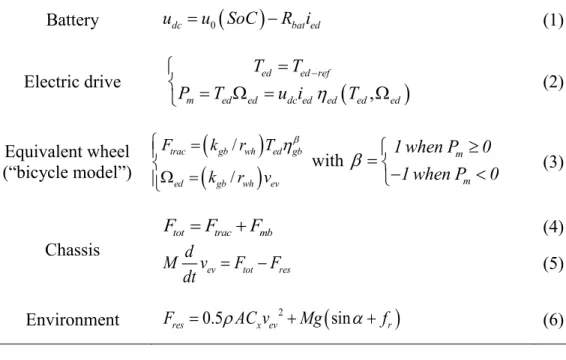
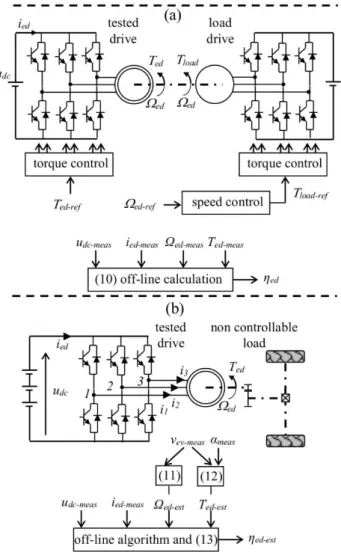
![Table 2. Electric vehicle parameters 146 parameter value gearbox ratio k gb 5.84 gearbox efficiency gb 0.98 wheels radius r wh [m] 0.2865 curb mass [kg] 562 A·C x [m 2 ] 0.7 f r 0.02](https://thumb-eu.123doks.com/thumbv2/123doknet/14606101.731762/10.893.315.580.167.385/table-electric-vehicle-parameters-parameter-gearbox-gearbox-efficiency.webp)
